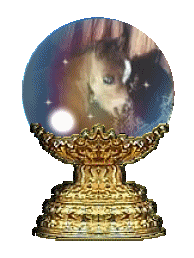
Update as of May 2014
There is at long last a dwarf test at the University of Kentucky, as a result of research by John Eberth for many years. It tests for the 4 main types of dwarfism in the miniature horse and we can now know which are carriers and which are not to avoid ever breeding a carrier to a carrier again.

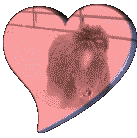
Hal's Page
Update: On April 30, 2004 at 4 and a half years old, we had Hal put to sleep very peacefully. His arthritis had gradually gotten much worse, and even with all kinds of joint supplements we could not help him enough. He was lying down more and more each day and would usually only get up to eat. So we finally knew it was time. But he will never be forgotten. He was a real sweetheart. :)
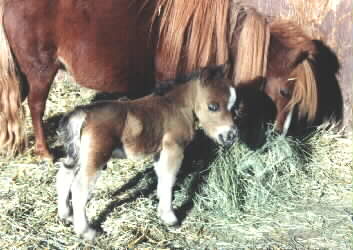
On September 28, 1999, our little 28.75" mare, Bertrands Blaze of Glory, had an adorable little colt. He was just 15.5" tall and weighed 16 lbs. We named him Glory Halleluiah! At about 6 weeks old it was becoming obvious that he was one of those special little beings known as dwarfs.
They are comparable to dwarfs in people, many times having limbs out of proportion, almost no neck, an underbite, sometimes breathing problems, and often many other physical handicaps. But they are extremely sweet natured and loveable.
Some of them, sadly, have to be put to sleep at birth as they are not viable, or would have a very short lifespan in much pain. But for those that have less handicaps, they can be loving pets and bring much joy. Hal is one of those.
For anyone who breeds minis on a large scale for very many years, they will eventually produce a little dwarf. This is probably partly because in the past dwarfs were often used in breeding programs, as size reducers, when that was more the focus instead of good conformation. It is probably also partly because in breeding down in size as a miniature breed, and with small size being one of the main things about dwarfs, it is also a very natural occurence for it to crop up from time to time. But today, most breeders are really striving to produce good conformation and would not consider breeding a dwarf, him or herself. At this point there is no test for dwarf genes for breeders to use. But John Eberth has worked so long on his research, starting way back in the 90's and should have tests available in the very near future.
Because many miniatures probably carry dwarf genes, which are thought to be recessive, it is usually a good idea not to breed again the same pair that produced a dwarf. However, if no horse who had ever produced a dwarf had continued to be bred to other partners, we would not have very many minis left today. It is that prevalent in the miniature breed.
Hal really only had the very short neck and the bowed front legs with big knees showing that he will most likely develop arthritis more as he matures. But he has a beautiful head and did have a perfect bite. It has gone off as he has grown. He loves people and has been a great little companion for different horses too. This works because we had him gelded at about 16 months of age.
He is up to 25" as a 4 year old.
In the past, and still often today, dwarfs also were hidden or destroyed at birth to keep from giving a bad name to a farm. Hopefully more breeders are realizing that they are a part of miniature breeding, not something to be ashamed of, and we need to learn all we can and study this if we are to try and gradually breed these genes out. Now that at least a few more people are talking about their little dwarfs, it is coming out that they come from all kinds of minis, often coming from Top Ten National champions, as well as all colors of horses, all heights, and many different bloodlines, even from countries all over the world. Once tests are available we will be able to responsibly not breed a carrier of a dwarf gene to another one carrying the same gene. And if this practice is followed we will still be able to keep excellent miniature horses in the breeding pool but never produce a dwarf.
At the bottom of this page is a Little King Farm perspective on dwarfism. I greatly admire their breeding program, and feel they look at things realistically. I also am so very grateful to John Eberth for his huge contribution to the breed with his dwarf research!
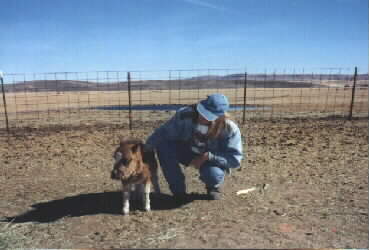
Hal at 5 weeks
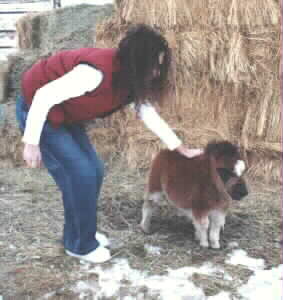
Hal at 7 weeks
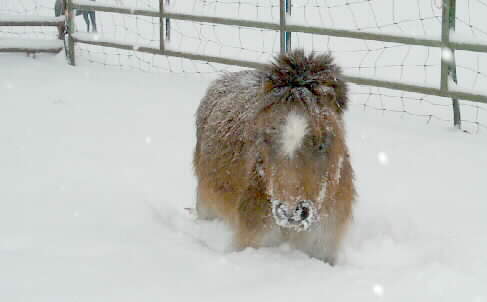
Hal playing in the snow at 13 months!
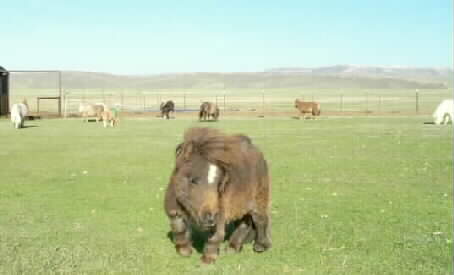
Hal at almost 20 months!
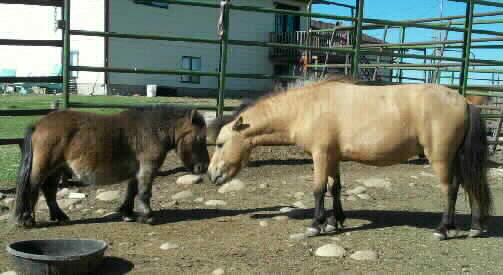
Hal at 22 months with Touchdown!
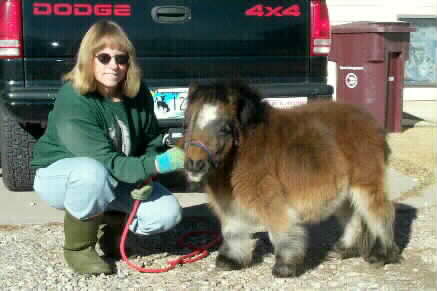
26 months old!
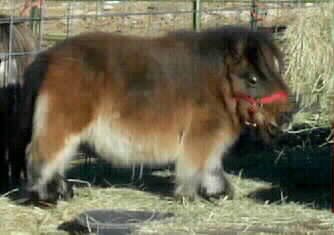
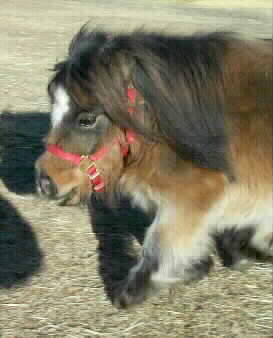
Hal at 3 and a quarter years! :)
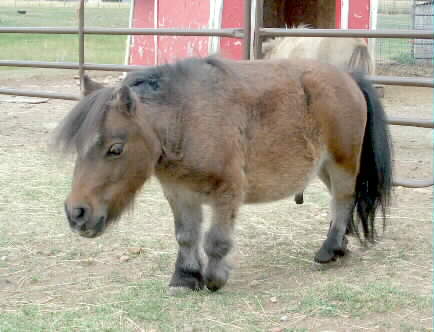
Hal at almost 4 years old!
__________________________________________________________
Dwarfism.......A Little King Farm Perspective
by Robin Mignone
Everyone interested and watching these threads needs to know a little background about John Eberth and his interest in improving the miniature horse breed and his interest in dwarfism in our miniature horse breed. In 1994 my brother John and my mom, Marianne sat down and discussed a particular breeding problem with a certain stallion we owned. As a result, our farm donated this stallion to University of Kentucky and Dr. Swerzcek (who was the head of Equine Pathology), for research on a particular breeding project he was working on at that time. The Stallion was Komokos Wee Willie that Little King Farm had purchased from Komokos Ranch along with Komokos Little King Supreme back in 1981. This donation was a major decision that had a definite financial impact on our farm at the time. Wee Willie was Reserve National Grand Champion Senior Stallion in 1985. He had produced for us, 2 National Champions and was considered a cornerstone stallion in the LKF breeding program at that time. Although Little King Farm was not breeding the number of mares then as we are now, we were still goal oriented in producing the best horses possible.This particular stallion was presenting not only a genetic problem but also a true loss of income problem for the farm. He was siring multiple dwarfs and foals with some of these pronounced characteristics.
As the breeding years went by, John and Mom, began to study and note the occurrences of dwarfs resulting in breeding Wee Willie and some of the other smaller horses with certain distinguishable characteristics (Komokos Don Juan and Komokos Apple Jack). These initial general observations sparked and set the stage for curiosity and educational interest. From Mom's breeding interests to John's later academic interest (as he later studied in undergraduate college genetics). It became a near passion to pursue the cause and occurrence of this anomaly.
Even though eliminating this horse from our breeding program did not eliminate some of the chances of producing dwarfs, it was an initial step into the understanding of this genetic problem. And it did set a pattern of occurrence and identifying characteristics in the minds of both Mom and John.
In 1976, when Little King Farm began, most of the very high priced horses were the smallest horses of the time. At the 1st Komoko Ranch Auction in Florida, the mares with dwarfs on their sides brought the highest prices along with the very very small stallions. Mom recalls that when she and dad purchased a little herd of mares from Bob Bridges of Komoko Ranch, one group of mares he had for sale under 28" were priced 3 times higher than the package they bought of mares 30" to 34". Small was considered better in that day. However, Mom felt the smaller mares did not have the proportion and look she wanted to produce and show. She felt that they had characteristics that were unusual and possibly genetically transferable.
As time went on John would collect DNA and info from any dwarf we had or he heard of. He would also collect blood from sires and dams and note the pedigree of the horse. Mom recalls how her freezer was always full of carcasses and blood that John had saved or other people had collected for him. Finally we just bought a freezer for such specimens. Mom remembers giving John $300.00 when he was in undergraduate school to buy unsundrie lab supplies that the school ( DePaw Univ.) would not provide and that John needed to research his samples etc. When John moved from his undergraduate school to UK grad school, he moved all his samples and has moved them a multitude of times since, including bodies! He has done more studying and genetic work on miniature horse dwarfs than anyone I know. In 1994 he did an internship at UC Davis under Ann Bowling and found that there was a problem because what they were calling a dwarf was not exactly what we called a dwarf. He also found that there are many different kinds/mutations of dwarfs as there are in other species. He also said that Ann was doing alot of her dwarf research on her own, due to lack of funds, and most of what she knew was in her head. Unfortunately all her research died with her before being well documented.
John's extensive work and commitment to this is a foundation to determining a way to test for certain kinds of dwarfism. He continues to be committed to this and UK and Gus Cothran* are directing him in his interest now. John has always funded this himself. He has solely put hundreds and hundreds of hours and thousands of dollars into this on his own . UK has had no current funding to help John so he is limited hopefully until now. Mom is working on a project to help the further studying of this dwarf issue and with the ultimate goal of a testing program. We as representatives of the Heritage Sale are hoping to donate a % of the gross sales at the Heritage Sale to this Program at the University of Kentucky and she would like to challenge all other miniature horse sales to do the same.
We, at LKF, are not an advocate of eliminating the miniatures that test positive for the dwarf gene from the breeding pool. That would have more of a negative effect on the breed as it is now. Entire farms and breeding programs would go out of business if you took away their main breeding stallion or majority of their mares because they carry a gene that can or cannot be passed on to future foals. A basic understanding of how genes are passed must be considered before jumping to final conclusion and elimination of these horses that carry the dwarf gene. We need to treat this genetic trait the same as the HYPP in Quarter Horses by identifying the gene/s and guide breeding programs accordingly. A horse that carries the dwarf gene may also carry traits that are so necessary for the refinement and structure of proportion and conformation for the future of the miniature horse.
We can imagine that people are afraid that their entire herd, years of work and money could be wiped out if this gene was identified and forced to be eliminated from the gene pool. It has been estimated by many experienced breeders that as many as 50-75% of minis carry this gene. If these were all eliminated - what would we breed? There would not be a large enough gene pool to substantiate the miniature horse economy and registries as they are now. It is much more benefical for all of the breeders, associations and businesses involved to learn how to live with the genetic profile these miniatures have and work within those parameters towards a common goal. In time, a gene like dwarfism can be minimalized and in long term eliminated thru genetic selection and knowledged breeding. The idea is not to scare people away, but to recognize the situation and look toward a future that is benefical for both horse and breeder.
Robin-LKF